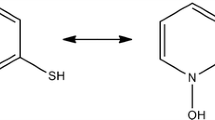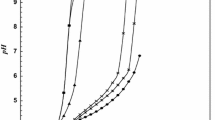Abstract
The protonation equilibria of uridine 5′-monophosphate disodium salt (UMP) was determined in binary solvent mixtures of water–methanol containing 0, 10, 15, 20, 25, 30, 35, 40, 45, and 50 % (v/v) methanol, using a combination of spectrophotometric and potentiometric methods at 25 °C and constant ionic strength (0.1 mol·dm−3 NaClO4). The protonation constants were analyzed using Kamlet, Abboud, and Taft parameters. A good linear correlation of the protonation constants (on the logarithmic scale) was obtained. Dual-parameter correlation of log10 K versus π* (dipolarity/polarizability) and α (hydrogen-bond donor acidity), as well as π* and β (hydrogen-bond acceptor basicity), gave good results in various aqueous solutions of methanol. Finally, the results are compared with CMP, a homolog of UMP, and are discussed in terms of the effect of the solvent on the protonation constants.





Similar content being viewed by others
References
Sigel, H.: Methods involving metal ions and complexes in clinical chemistry. In: Sigel, H. (ed.) Metal Ions in Biological Systems, vol. 16. Marcel Dekker, New York (1983)
Sigel, H.: Interactions of metal ions with nucleotides and nucleic acids and their constituents. Chem. Soc. Rev. 22, 255–267 (1993)
Casassas, E., Tauler, R., Marques, I.: Interactions of H+ and Cu(II) ions with poly(adenylic acid): study by factor analysis. Macromolecules 27, 1729–1737 (1994)
Casassas, E., Gargallo, R., Izquierdo-Ridorsa, A., Tauler, R.: Application of multivariate curve resolution to voltammetric data. Part 1. Study of Zn(II) complexation with some polyelectrolytes. React. Funct. Polym. 27, 1–14 (1995)
Barron, D., Jimenez-Lozano, E., Irles, A., Barbosa, J.: Influence of pH and pK a values on electrophoretic behaviour of quinolones in aqueous and hydro-organic media. J. Chromatogr. A 871, 381–389 (2000)
Helboe, T., Hansen, S.H.: Separation of nucleosides using capillary electrochromatography. J. Chromatogr. A 836, 315–324 (1999)
Staszak, Z., Bartecki, A.: Influence of the bulk and donor-acceptor properties of solvent on ligand field spectra. Spectr. Lett. 22, 1193–1201 (1989)
Reichardt, C.: Solvents and Solvent Effects in Organic Chemistry, 3rd edn. VCH, New York (2004)
Gharib, F., Feizabadi, M., Soltani, L.: Equilibrium studies of thallium(I) complexes with cytidine 5′-monophosphate in different aqueous solutions of methanol. J. Mol. Liq. 182, 64–69 (2013)
Pehrsson, L., Ingman, F., Johansson, A.: Acid-base titrations by stepwise additions of equal volumes of titrant with special reference to automatic titrations. Theory, discussion of the Gran functions, the Hofstee method and equivalence volumes. Talanta 23, 769–780 (1976)
Gameiro, P., Reis, S., Lima, J.L.F.C., de Castro, B.: Calibration of pH glass electrodes by direct strong acid/strong base titrations under dilute conditions. Anal. Chim. Acta 405, 167–172 (2000)
Ferrer, J.S., Couallier, E., Rakib, M., Durand, G.: Electrochemical determination of acidity level and dissociation of formic acid/water mixtures as solvent. Electrochim. Acta 52, 5773–5780 (2007)
Gharib, F., Farajtabar, F., Farahani, A.M., Bahmani, F.: Solvent effects on protonation constants of tryptophan in some aqueous aliphatic alcohol solutions. J. Chem. Eng. Data 55, 327–332 (2010)
Beck, M.T., Nagypal, I.: Chemistry of Complex Equilibria. Ellis Harwood, New York (1990)
Leggett, D.J.: Computation Methods for the Determination of Formation Constants. Plenum Press, New York (1985)
Meloun, M., Javurek, M., Havel, J.: Multiparametric curve fitting. A structural classification of programs for analyzing multicomponent spectra and their use in equilibrium-model determination. Talanta 33, 513–524 (1986)
Massoud, S.S., Sigel, H.: Metal ion coordinating properties of pyrimidine-nucleoside 5′-monophosphates (CMP, UMP, TMP) and simple phosphate monoesters including d-ribose 5′-monophosphate. Establishment of relations between complex stability and phosphate basicity. Inorg. Chem. 27, 1447–1453 (1988)
Izatt, R.M., Christensen, J.J., Rytting, J.H.: Sites and thermodynamic quantities associated with proton and metal ion interaction with ribonucleic acid, deoxyribonucleic acid, and their constituent bases, nucleosides and nucleotides. Chem. Rev. 71, 439–446 (1971)
Saenger, W.: Principles of Nucleic Acid Structures. Springer, New York (1984)
Barbosa, J., Barron, D., Beltran, J.L., Buti, S.: On the role of solvent in acid–base equilibria of diuretics in acetonitrile–water mixed solvents. Talanta 45, 817–827 (1998)
Barbosa, J., Toro, I., Sanz-Nebot, V.: Acid-base behaviour of tripeptides in solvents used in liquid chromatography. Correlation between pK values and solvatochromic parameters of acetonitrile–water mixtures. Anal. Chim. Acta 347, 295–304 (1997)
Demirelli, H., Koseoglu, F.: Solvent and substituent effects on the protonation of anilines in dioxane–water mixtures. J. Solution Chem. 33, 1501–1515 (2004)
Buhvestov, U., Rived, F., Rafols, C., Bosch, E., Roses, M.: Solute–solvent and solvent–solvent interactions in binary solvent mixtures. Part 7. Comparison of the enhancement of the water structure in alcohol-water mixtures measured by solvatochromic indicators. J. Phys. Org. Chem. 11, 185–192 (1988)
Shamel, A., Saghiri, A., Jaberi, F., Farajtabar, A., Mofidi, F., Khorrami, S.A., Gharib, F.: Solvent Effect on tautomeric and microscopic protonation constants of glycine in different aqueous solutions of methanol and ethanol. J. Solution Chem. 41, 1020–1032 (2012)
Jabbari, M., Gharib, F.: Solvent dependence on antioxidant activity of some water-insoluble flavonoids and their cerium(IV) complexes. J. Mol. Liq. 168, 36–41 (2012)
Jabbari, M., Gharib, F.: Solute-solvent effects on protonation equilibrium of some water-insoluble flavonoids. J. Solution Chem. 40, 561–574 (2011)
Jabbari, M., Gharib, F.: Equilibrium studies of triphenyltin(IV) complexes with glycine, glycyl-glycine, and glycyl-glycyl-glycine in different aqueous solutions of ethanol. Can. J. Chem. 88, 877–885 (2010)
Farajtabar, A., Jaberi, F., Gharib, F.: Preferential solvation and solvation shell composition of free base and protonated 5, 10, 15, 20-tetrakis(4-sulphonatophenyl)porphyrin in aqueous organic mixed solvents. Spectrochim. Acta A. 83, 213–220 (2011)
Taft, R.W., Abboud, J.L.M., Kamlet, M.J.: Linear solvation energy relationships. 28. An analysis of Swain’s solvent “acidity” and “basicity” scales. J. Org. Chem. 49, 2001–2005 (1984)
Kamlet, M.J., Abboud, J.L.M., Abraham, M.H., Taft, R.W.: Linear solvation energy relationships. 23 A comprehensive collection of the solvatochromic parameters, π*, α; and β; and some methods for simplifying the generalized solvatochromic equation. J. Org. Chem. 48, 2877–2887 (1983)
Kamlet, M.J., Gal, J.F., Maria, P.C., Taft, R.W.: Linear solvation energy relationships. Part 32. A coordinate covalency parameter, ξ; which, in combination with the hydrogen bond acceptor basicity parameter, β; permits correlation of many properties of neutral oxygen and nitrogen bases (including aqueous pK a). J. Chem. Soc. Perkin Trans. 2, 1583–1589 (1985)
Kamlet, M.J., Taft, R.W.: Linear solvation energy relationships. Local empirical rules—or fundamental laws of chemistry? A reply to the chemometricians. Acta Chem. Scand. Ser. B 39, 611–628 (1985)
Maleki, N., Haghighi, B., Safavi, A.: Evaluation of formation constants, molar absorptivities of metal complexes, and protonation constants of acids by nonlinear curve fitting using Microsoft Excel Solver. Microchem. J. 62, 229–236 (1999)
Puranik, S.M., Kumbharkhane, A.C., Mehrotra, S.C.: The static permittivity of binary mixtures using an improved Bruggeman model. J. Mol. Liq. 59, 173–177 (1994)
Acknowledgments
Financial support by the Research Council of Islamic Azad University, Roudehen Branch is gratefully acknowledged.
Author information
Authors and Affiliations
Corresponding author
Rights and permissions
About this article
Cite this article
Soleimani, F., Gharib, F. Protonation Constants of Uridine 5′-Monophosphate in Different Aqueous Solutions of Methanol. J Solution Chem 43, 763–773 (2014). https://doi.org/10.1007/s10953-014-0161-8
Received:
Accepted:
Published:
Issue Date:
DOI: https://doi.org/10.1007/s10953-014-0161-8




